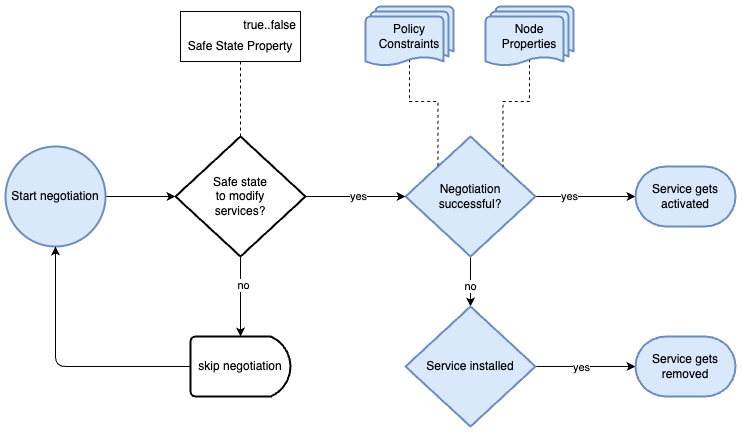...
Goal: prevent workloads from changing while the edge node is in a "safety critical state".
The changefreeze state will be initiated with a call to the agent’s /node/configstate api. If agent has one of the following conditions, it cannot enter a changefreeze state and the api will respond with a rejection.
node is not currently in “configured” state
node has an nmp in the initiated state
waiting for a particular proposal (received an agreement cancel for policy upgrade/downgrade or userinput change)
node has an unfinalized agreement
mms model download in progress
In this case, it is the responsibility of the entity calling the api to retry the refused call after a period of time.
The ability to reject the state change allows the agent to ensure it’s agreements are in the “correct” state before freezing. The 4th bullet above assigns a new meaning to the TerminatedReason field that is stored in all cancelled agreements. To motivate this change, consider a node running a service when a newer version of the service is added to the deployment policy. The agbot will cancel the current agreement. If at this point, the changefreeze state is enabled, the node will not get the proposal for the upgraded service and will be frozen in an incorrect state. Instead, when the node api call is made to enable changefreeze, the node should look at recently cancelled agreements and see that there is an agreement cancelled for an upgrade and no new proposal has been received for this policy yet. Therefore the node should reject the changefreeze state as not node is likely not in the intended state. An agreement is defined as recently cancelled here if its AgreementProtocolTerminatedTime is after the changes worker’s lastHeartbeat.
If the node determines that it can enter the changefreeze state, the agent will update its resource in the exchange to reflect the changefreeze state.
Once the agent enters the changefreeze state the agent’s behavior will change in the following ways:
set maximum changes from exchange to 0 (heartbeat but don’t poll for changes)
do not give the cron job any updates to perform
do not allow any agent upgrades to proceed
attempt to restart services if containers are missing (instead of cancelling the agreement)
The edge sync service on the node will continue to run, but communication with CSS will be suspended.
To end the changefreeze state the agent’s /node/configstate api is called to set the state back to “configured”. After this occurs, the agent may have missed changes or updates to its agreements, since relevant changes may have expired and been dropped from the exchange table the agent needs to run its exchange sync protocol. The agent should also send AgreementVerifications for each of its agreements. Given the lifespan of messages in the exchange, the agreementverification message needs to be modified to include the time of last update for secrets and policies. If the last update time in the agent’s agreement is before the agbot’s, then the agbot will resend the missed updatesFor the aspect of HA groups it can be assumed that all nodes in this group are frozen at the same time (i.e. redundant nodes in a vehicle - the external critical state would apply to all).
| Expand | ||
|---|---|---|
| ||
Possibly send heartbeats but not accept node property updates or changes Possibly allow geofencing information updates? Where the edge node is located might be important to know. Aha "The car is on the driveway, geofenced at home" is an important clue that might allow the agent to trigger changes to workloads. If the car is at the supermarket, not a good idea. Governance should restart the agreement, if it dies unexpectedly - tricky? node health state ? HA node groups need to skip over nodes that are in ChangeFreeze state. This is orthogonal to the reason for a HA group. Unsupported configuration. Let the external change "The car is in park and the GPS knows that the car is "home" - Call the API to change out of ChangeFreeze state". The agent never decides for itself that it out of ChangeFreeze state Build a "Agent Config State" API If a secret changes, the agbot sends a message of a change, if the agent doesn't see or handle that message, what happens? Max? Would the agreement get cancelled if the agent doesn't reply? MMS handling of agents in ChangeFreeze status - ESS should also go into ChangeFreeze state as well. It should not look for model updates while the edge node is in changefreeze state. Node Management- behavior? |
...
hzn node freeze - enable the changefreeze state
hzn node unfreeze - disable the changefreeze state
...
